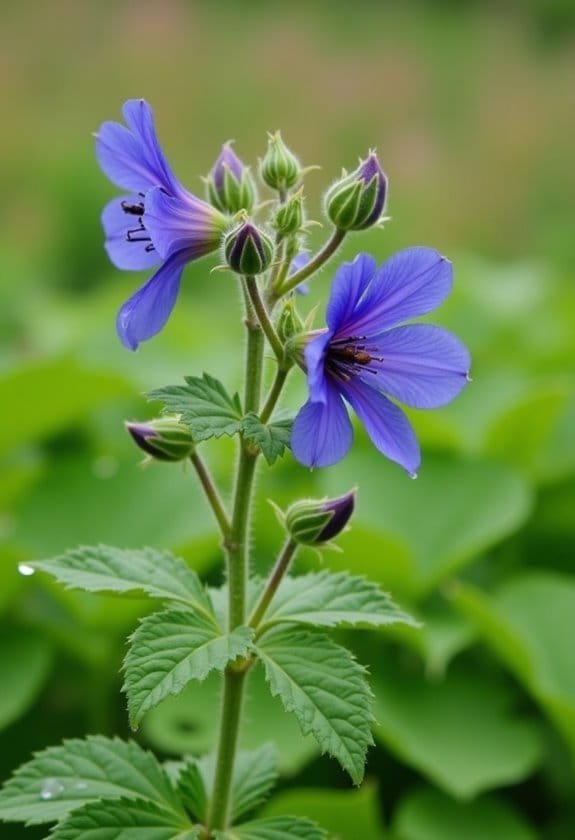Geranium pratense, the elegant Meadow Cranesbill, is a hardy perennial that graces gardens with its deeply-lobed foliage and striking blue-violet blooms from late spring through summer. Native to Europe and Asia, it thrives in USDA zones 3-9, reaching heights of 2-3 feet with a matching spread. The plant's saucer-shaped flowers feature intricate purple veining and produce substantial nectar, making it an essential resource for pollinators. It's remarkably adaptable, flourishing in both full sun and partial shade while requiring minimal maintenance beyond well-draining soil and moderate watering. The plant's rich botanical heritage and ecological benefits make it an intriguing subject for garden enthusiasts.
Main Points
- Geranium pratense is a hardy perennial with blue-violet flowers and deeply-lobed foliage, growing 2-3 feet tall in meadows.
- Thrives in USDA zones 3-9, preferring well-drained soil and full sun to partial shade conditions.
- Features saucer-shaped flowers with five petals and dark veining, blooming from late spring through summer.
- Produces significant nectar for pollinators and requires minimal maintenance beyond deadheading spent blooms and moderate watering.
- Pairs effectively with other perennials and benefits from spring planting with organic compost for optimal growth.
Introduction

Geranium pratense, commonly known as Meadow Cranesbill, stands as a distinguished member of the Geraniaceae family, prized for its ornamental and ecological value.
The robust perennial reaches impressive heights of 2-3 feet, featuring deeply-lobed foliage and striking saucer-shaped flowers in shades of blue and violet that grace gardens from late spring through summer.
This versatile plant has earned its reputation through a combination of low-maintenance requirements, reliable performance across USDA zones 3-9, and significant contributions to pollinator populations through its abundant nectar production.
Common Name
Known widely as Meadow Cranesbill, this perennial flowering plant draws its common name from its natural habitat and distinctive seed pods. Geranium pratense earned its descriptive moniker from its prevalence in meadows and grasslands, where its striking blue-violet flowers grace the landscape from late spring through midsummer.
The "Cranesbill" portion of its name derives from a particularly distinctive feature: its elongated seed capsules that bear a remarkable resemblance to the bill of a crane. This characteristic is shared among members of the Geraniaceae family, contributing to the widespread use of this common name.
While Meadow Cranesbill serves as the primary common name, the species has acquired several alternative colloquial titles throughout its range, including Common Cranesbill and Wild Geranium. The name Crowfoot has also been applied to this plant, though this alternative designation is less frequently used.
These various common names reflect the plant's widespread recognition and cultural significance across different regions, while maintaining references to its physical characteristics and natural habitat preferences.
Scientific Name
Beyond its familiar common names, the formal scientific designation Geranium pratense represents this plant's taxonomic identity within the Geraniaceae family. The binomial nomenclature, established through rigorous botanical classification, reflects both the genus (Geranium) and specific epithet (pratense) of this remarkable perennial.
As a species native to Europe and parts of Asia, Geranium pratense earned its scientific name through careful observation of its habitat preferences and morphological characteristics. The genus name "Geranium" derives from the Greek word "geranos," meaning crane, referencing the distinctive beak-like fruit formation characteristic of the family.
The specific epithet "pratense" comes from the Latin word for meadow, aptly describing its natural growing environment.
This taxonomic classification has proven invaluable for botanical research and horticultural development, leading to numerous cultivars that have received the prestigious Award of Garden Merit.
The scientific name serves as a universal identifier, enabling researchers and gardeners worldwide to precisely communicate about this species, while distinguishing it from the approximately 420 other Geranium species currently recognized in botanical literature.
Overview
A graceful perennial native to Europe and Asia, Meadow Cranesbill stands as a cherished garden plant valued for its striking blue-violet blooms and deeply-lobed foliage.
Geranium pratense showcases its ornamental prowess through saucer-shaped flowers that emerge in late spring, creating a fascinating display that persists through mid-summer.
This robust species reaches impressive heights of 2-3 feet, forming dense clumps that contribute to its architectural presence in garden settings.
While performing best in full sun or part shade, Meadow Cranesbill demonstrates remarkable adaptability across USDA hardiness zones 3-9, thriving in various well-drained soil conditions.
Its ecological significance extends beyond mere aesthetics, as the plant produces substantial quantities of nectar—approximately 1.3-1.5 mg daily during flowering periods.
In cottage gardens and naturalized landscapes, Geranium pratense serves dual purposes: enhancing visual appeal through its seasonal transformations, including bronze-tinted autumn foliage, while supporting local biodiversity by attracting essential pollinators.
This versatile perennial has earned its reputation as both an ornamental cornerstone and a valuable contributor to garden ecosystems.
Key Features
Geranium pratense exemplifies impressive architectural qualities in the garden, forming robust clumps that reach 2-3 feet in height with deeply-lobed foliage that creates lasting visual interest.
The plant's most striking feature is its array of large, saucer-shaped flowers in vivid blue to violet hues, each displaying five distinct petals that catch the eye throughout the blooming period.
Its seasonal transformation includes an autumn display when the characteristic leaves shift to rich bronze tones, complementing the plant's naturally mounded form and extending its ornamental value beyond the flowering season.
Growth Size
Throughout its growing season, this robust perennial develops into a substantial garden presence, reaching heights of 2-3 feet (60-90 cm) with an impressive spread of up to 2 feet (60 cm). The Geranium pratense's balanced proportions create an appealing architectural element in garden borders, where its upright growth habit commands attention without overwhelming neighboring plants.
The plant's growth pattern is supported by its extensive fibrous root system, which anchors the foliage and enables steady vertical development throughout the season. As the plant matures, it forms a dense clump of deeply-lobed leaves, creating a lush foundation from which its flowering stems emerge.
The moderate growth rate allows gardeners to easily manage its expansion, while its natural tendency to self-seed guarantees sustainable garden coverage over time. In ideal conditions, with well-drained loamy soil and adequate spacing, each specimen develops into a self-supporting mound that maintains its shape throughout the growing season.
This consistent growth pattern, combined with its naturalizing abilities, makes Geranium pratense an excellent choice for both formal gardens and naturalistic plantings.
Appearance
Distinguished by its striking saucer-shaped blooms, the Meadow Cranesbill commands attention with vibrant purple to blue flowers that emerge from late spring through mid-summer. Each flower showcases five perfectly formed petals adorned with intricate dark purple veining that serves as natural runway markers, guiding pollinators toward their nectar-rich destination.
The Geranium pratense's foliage proves equally impressive, featuring deeply divided leaves with 7-9 distinct lobes that create an elegant backdrop for the abundant blooms.
As autumn approaches, these verdant leaves undergo a dramatic transformation, adopting rich bronze hues that extend the plant's ornamental value well beyond its flowering period. After the blossoms fade, elongated seed capsules develop, resembling the distinctive bill of a crane, which explains the plant's common name.
These architectural seed structures contribute to the plant's ability to naturalize gracefully throughout the garden. Gardeners often cut back the stems after the initial flush of flowers to encourage a second blooming period and maintain the plant's tidy appearance through the growing season.
Flowering Season
The vibrant display of Meadow Cranesbill reaches its zenith from June through September, when the garden comes alive with masses of blue to violet blooms. Recognized by the Royal Horticultural Society for its outstanding garden performance, Geranium pratense (Meadow Cranesbill) produces an abundance of saucer-shaped flowers, each featuring five distinctive petals that create a stunning visual impact.
What makes this flowering period particularly remarkable is the plant's substantial nectar production, generating between 1.3 and 1.5 mg every 24 hours with an impressive sugar content ranging from 57% to 71%.
Throughout the United States, gardeners can extend this flowering season through strategic maintenance practices. By removing spent flowering stems regularly, they'll encourage fresh growth and subsequent blooming cycles.
The plant demonstrates remarkable resilience, often producing a second flush of flowers when cut back after its initial blooming period. This characteristic makes it an invaluable addition to perennial borders, as it maintains visual interest throughout the summer months while supporting local pollinators with its rich nectar resources.
Growing Requirements

Geranium pratense demonstrates remarkable adaptability, flourishing in full sun to full shade conditions across USDA hardiness zones 3-9.
The plant's success depends greatly on well-drained, loamy soil conditions, which provide essential nutrients while preventing waterlogged roots that could lead to deterioration.
For ideal growth, these hardy perennials require moderate watering practices and minimal fertilization, preferably through the integration of organic compost into their growing medium.
Light
When it comes to light requirements, Meadow Cranesbill thrives best in full sun conditions, though it demonstrates remarkable adaptability to both partial and full shade environments.
The plant's sun exposure effects are most evident in its flowering patterns, with maximum blooms occurring in locations that receive abundant direct sunlight during the growing season.
While shade tolerance benefits include the ability to establish successful colonies in less illuminated garden spaces, ideal flowering performance is achieved through strategic light adaptation strategies.
Plants growing in full sun typically produce more abundant blooms from late spring through mid-summer, creating spectacular displays in garden settings.
The species' versatility across USDA hardiness zones 3-9 further emphasizes its exceptional ability to adapt to varying light conditions.
Gardeners should note that even in partially shaded locations, Geranium pratense maintains healthy foliage growth, though flowering may be slightly reduced.
This adaptability makes it an excellent choice for diverse garden situations, from sunny border plantings to woodland garden settings where light levels fluctuate throughout the day.
Soil
Successful cultivation of Meadow Cranesbill depends heavily on proper soil conditions, with well-drained, loamy soil providing the ideal growing environment.
While this versatile perennial demonstrates remarkable adaptability across various soil types, implementing proper soil drainage techniques guarantees prime root development and prevents waterlogging issues that could compromise plant health.
For gardeners working with challenging soil compositions, several soil amendment options can enhance growing conditions. Adding organic compost not only improves soil structure but also provides essential nutrients that support vigorous growth and abundant flowering.
When considering soil pH impact, Geranium pratense shows flexibility, though it performs best in slightly acidic to neutral conditions ranging from 6.0 to 7.0.
Container growers should pay particular attention to maintaining consistent soil moisture, as potted specimens have more specific hydration requirements than their garden-planted counterparts.
The incorporation of moisture-retentive materials, such as well-aged compost or leaf mold, can help achieve this delicate moisture balance while simultaneously enriching the growing medium with beneficial organic matter and microorganisms.
Water
Throughout the growing season, proper watering practices play an essential role in cultivating healthy Geranium pratense specimens. The implementation of appropriate watering techniques guarantees ideal growth conditions, with an emphasis on maintaining consistently moist, well-draining soil that prevents waterlogged roots.
While young plants require regular moisture to establish strong root systems, mature Geranium pratense demonstrates remarkable drought resilience, adapting to various garden conditions like a seasoned survivor. This adaptability doesn't eliminate the need for mindful irrigation, particularly during extended dry spells when supplemental watering becomes necessary for maintaining vibrant foliage and prolific blooming.
Monitoring soil moisture levels is critical, as these plants thrive in a balanced environment that avoids extremes. Gardeners should allow the top layer of soil to dry slightly between waterings, creating a rhythm that mimics natural precipitation patterns.
The key to success lies in preventing oversaturation, which can lead to root rot, while providing adequate hydration during significant growth periods. This measured approach to irrigation supports the plant's natural cycles and promotes long-term health.
Temperature
Geranium pratense's remarkable temperature adaptability spans USDA hardiness zones 3-9, showcasing its resilience in diverse climates. This perennial's climate adaptability enables it to withstand temperature extremes, from the frigid winters of zone 3, where temperatures can plummet to -40°F, to the moderate conditions of zone 9.
In terms of seasonal fluctuations, this hardy plant demonstrates impressive versatility in both cold and warm conditions. While it thrives in full sun exposure, Geranium pratense also performs admirably in partial shade, particularly in regions where summer temperatures consistently exceed 85°F.
The plant's temperature tolerance is enhanced by its well-developed root system, which helps regulate heat stress during warm periods.
During the establishment phase, maintaining moderate soil temperatures through proper mulching can greatly impact the plant's ability to adapt to local conditions.
Once established, Geranium pratense exhibits remarkable resilience to temperature variations, though it performs best in regions where summer temperatures remain below 90°F. This adaptability makes it an excellent choice for gardens experiencing considerable temperature fluctuations throughout the growing season.
Pollinator Criteria
Geranium pratense's abundant nectar production, ranging from 1.3 to 1.5 mg per day with sugar concentrations of 57-71%, makes it particularly attractive to beneficial pollinators.
The plant's distinctive blue-violet flowers feature dark veins that act as natural landing strips, guiding bees and other insects toward their sweet reward at the flower's center.
These pollinator-friendly characteristics establish G. pratense as an essential contributor to local ecosystems, supporting honey production while ensuring successful cross-pollination through its specialized flower structure.
Attracted Pollinators
Several characteristics of G. pratense make it a prime attraction for pollinators. The plant's consistent nectar availability, producing 1.3 to 1.5 mg every 24 hours, creates a reliable food source that draws diverse pollinating species throughout its blooming period.
The remarkably high sugar content in its nectar, ranging from 57% to 71%, proves particularly enticing to bee populations, which recognize this meadow flower as a premium foraging destination.
The pollinator diversity attracted to G. pratense is enhanced by its strategic flowering timeline, with blooms appearing from late spring through mid-summer when pollinator activity reaches its peak.
The plant's large, saucer-shaped flowers, displaying vibrant blue to violet hues, serve as visible beacons to passing insects, while specialized darker veins act as natural landing strips guiding pollinators to nectar sources.
This floral attraction mechanism greatly improves foraging efficiency, particularly for bees, which have evolved to recognize these visual cues.
As a melliferous herb, G. pratense plays an essential role in supporting local bee populations and contributes considerably to honey production within its ecosystem.
Pollination Method
The pollination process of G. pratense operates through a highly specific set of criteria that matches the plant's characteristics with its most effective pollinators. The flower's bluish-violet petals and distinctive dark veins create an intricate roadmap, directing pollinator interactions toward the nectar-rich center, where substantial rewards await beneficial insects.
The plant's sophisticated nectar strategies involve producing a generous 1.3 to 1.5 mg of nectar daily, with remarkably high sugar concentrations ranging from 57% to 71%. This abundant nectar production, combined with the flower's saucer-shaped architecture and dark purple anthers, has evolved to facilitate efficient pollen transfer while ensuring maximum biodiversity benefits for the surrounding ecosystem.
During its strategic flowering period from late spring through mid-summer, G. pratense serves as an essential melliferous resource when pollinator populations require consistent nutrition.
The plant's contribution to local honey production extends beyond simple nectar provision, as its extended blooming season helps maintain stable bee populations, creating a sustainable cycle of pollination that supports both the species' reproduction and broader ecosystem health.
Care & Maintenance

Geranium pratense's care requirements start with proper planting in well-draining loamy soil, where the crown sits slightly above ground level to prevent rot.
Ongoing maintenance calls for strategic deadheading of spent blooms and yellowed foliage, coupled with moderate watering that keeps soil consistently moist but never waterlogged.
The plant's adaptable nature makes it an excellent companion for other perennials that share similar soil and light preferences, including Alchemilla mollis and Campanula species.
Planting Tips
Creating a thriving garden with Geranium pratense begins with proper care and maintenance routines. The key planting techniques involve selecting well-drained, loamy soil and positioning plants where they'll receive full sun to partial shade exposure, ensuring ideal growth conditions for these hardy perennials.
Seasonal timing plays an important role in successful establishment, with spring being the best period for introducing new plants through various propagation methods. Proper soil preparation includes incorporating organic compost to enhance soil structure while maintaining a balanced nutrient profile that won't overwhelm these relatively low-maintenance plants.
When establishing new specimens, it's vital to space them appropriately, allowing sufficient room for their mature spread while considering their eventual height of up to 24 inches. The planting hole should be twice the width of the root ball, with the crown positioned slightly above soil level to prevent water accumulation around the stem.
While initial watering needs are moderate, these resilient plants develop drought tolerance once established, making them excellent choices for gardeners seeking sustainable landscaping options.
Ongoing Care
Maintaining ideal health of Geranium pratense requires consistent but minimal attention throughout the growing season. Regular pruning techniques focus on removing spent flowers and yellowing foliage, which not only maintains the plant's aesthetic appeal but also channels energy into producing fresh growth and vibrant blooms.
When it comes to fertilization tips, this hardy perennial thrives with a light touch. Incorporating organic compost into the soil provides sufficient nutrients, eliminating the need for intensive feeding schedules that might compromise the plant's natural vigor.
The plant's moderate watering needs should be monitored carefully, as waterlogged conditions can lead to detrimental root rot.
For long-term success, effective propagation methods include spring division, which simultaneously rejuvenates existing plants and creates new specimens.
While Geranium pratense demonstrates remarkable resistance to pests and diseases, vigilant observation helps identify potential issues like vine weevil infestations or powdery mildew before they become serious problems. Regular inspection of foliage, particularly during humid conditions, guarantees early detection and treatment of any emerging concerns.
Suggested Companions
When planning your garden design, you'll find that Geranium pratense flourishes alongside carefully selected companion plants that share similar growing requirements. Thoughtful plant combinations can create a harmonious display while supporting beneficial wildlife in your garden.
For ideal garden aesthetics, pair meadow cranesbill with vibrant perennials like Echinacea and Rudbeckia, which thrive under similar conditions. These combinations create stunning visual displays throughout the growing season while attracting diverse pollinator benefits to your garden space.
Consider incorporating Salvia and Achillea in cottage-style plantings, as these companions enhance the natural, meadow-like appearance while supporting local pollinators.
To maximize ground coverage and maintain soil health, integrate low-growing Thymus varieties around the base of your Geranium pratense. For dimensional interest, position taller specimens like Delphinium or Astilbe behind the cranesbill to create an engaging layered effect.
Regular maintenance, including deadheading spent blooms and removing aged foliage, guarantees both the Geranium pratense and its companion plants maintain their vigor and visual appeal throughout the growing season.
Common Issues
While Geranium pratense exhibits strong natural resistance, it can face challenges from vine weevils, capsid bugs, sawflies, and powdery mildew that require regular monitoring.
The plant's susceptibility to root rot in waterlogged conditions makes proper soil drainage and careful watering practices essential components of preventive care.
Gardeners can effectively manage these issues through targeted solutions like maintaining ideal soil structure, implementing proper spacing for air circulation, and promptly addressing pest infestations with appropriate organic or chemical controls.
Pests/Diseases
The hardy Geranium pratense exhibits strong natural resistance to most pests and diseases, though it can face a few common challenges. Primary concerns include vine weevil, which attacks the roots, capsid bug that damages foliage, and sawflies that can defoliate plants if left unchecked.
Implementing integrated pest management strategies, such as regular monitoring and prompt removal of affected plant material, helps maintain the plant's natural disease resistance.
In humid conditions, powdery mildew can develop, particularly when air circulation is compromised around densely planted specimens. Disease resistance strategies include maintaining proper spacing between plants and ensuring adequate airflow through selective pruning of surrounding vegetation.
Creating an environment that supports beneficial insect attraction, such as ladybugs and parasitic wasps, naturally helps control pest populations without chemical intervention.
Cultural practices play an essential role in prevention, with well-drained soil being paramount to avoid root rot and other fungal complications.
Regular inspection of foliage, combined with immediate removal of affected leaves and proper garden hygiene, greatly reduces the risk of disease spread within established plantings.
Solutions
Most common issues with Geranium pratense can be addressed through straightforward solutions and preventive care.
Effective pest management strategies include regular monitoring for vine weevils, capsid bugs, and sawflies, while maintaining proper soil drainage helps prevent root-related problems that might attract these pests.
Disease prevention techniques focus on proper plant maintenance and spacing. Regular removal of spent flowers and old foliage not only keeps the plant looking tidy but also reduces the risk of powdery mildew development.
When flowering diminishes, strategic pruning after the first bloom cycle can stimulate a second flush of flowers, rejuvenating the plant's appearance and vigor.
Organic fertilization methods prove particularly effective for Geranium pratense, as these plants don't require intensive feeding.
A light application of organic compost provides sufficient nutrients without overwhelming the plant's natural growth patterns.
In cases where waterlogging becomes an issue, improving soil drainage through the addition of organic matter and ensuring proper spacing between plants can help maintain ideal growing conditions.
Summary

Beautiful and hardy, Geranium pratense stands as a remarkable perennial known for its striking blue-violet blooms and adaptable nature. Its impressive height of 2-3 feet and clump-forming growth pattern make it an excellent choice for diverse garden designs, while its robust constitution guarantees lasting planting benefits across USDA zones 3-9.
The ecological impact of Meadow Cranesbill extends far beyond its ornamental appeal, serving as an essential resource for local pollinators through its generous nectar production of 1.3-1.5 mg daily.
This botanical powerhouse demonstrates remarkable resilience in well-drained soils, requiring minimal maintenance once established, while actively contributing to soil stability and erosion prevention. The plant's impressive sugar content, ranging from 57% to 71%, makes it a key component in supporting biodiversity within garden ecosystems.
As gardens face increasing environmental pressures, Geranium pratense emerges as a versatile solution, combining aesthetic charm with ecological functionality. Its disease resistance and minimal care requirements further cement its position as an irreplaceable addition to both ornamental gardens and naturalized landscapes.


